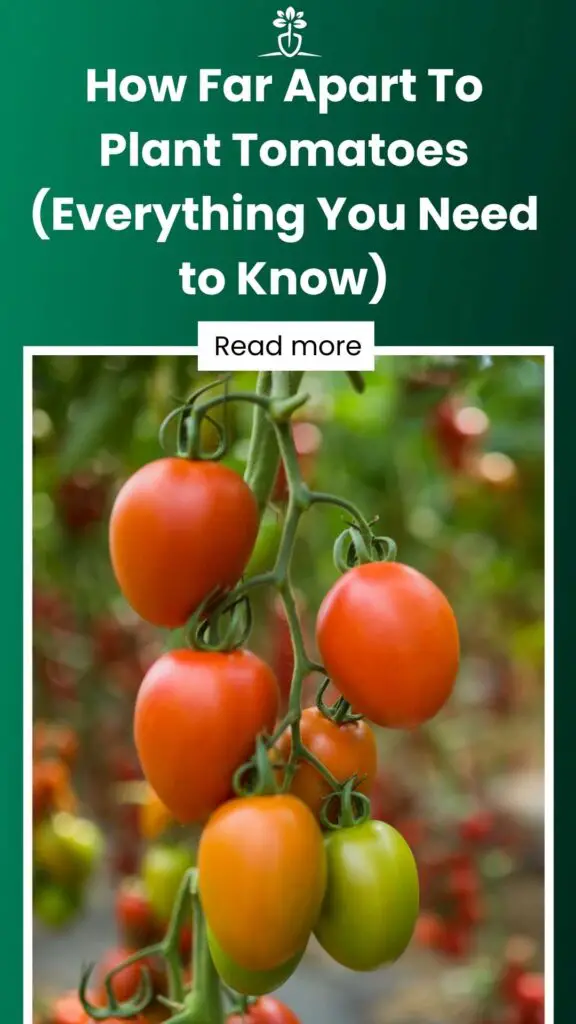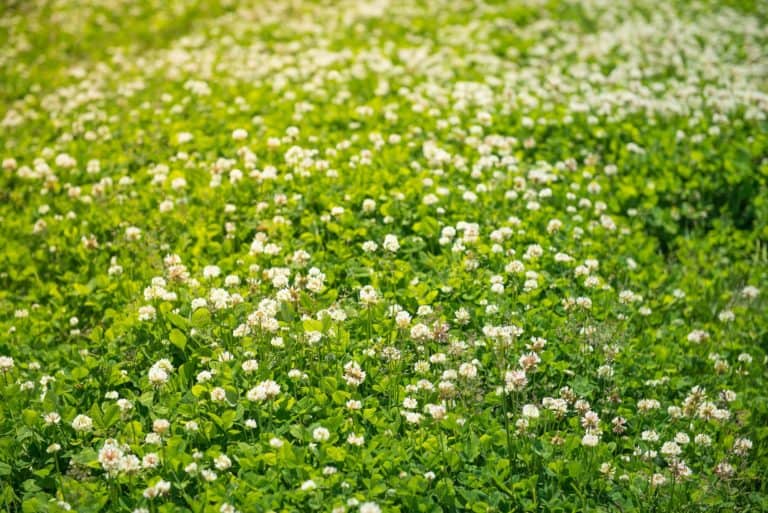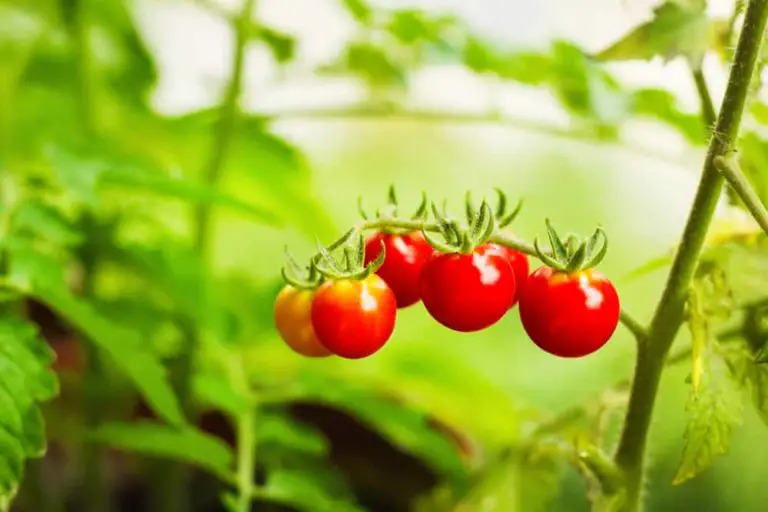How Far Apart To Plant Tomatoes (Everything You Need to Know)
Dreaming of turning a small part of the yard into a jungle full of tomatoes for a huge harvest? Hold your horses. Tomato plants love space to grow. But what’s the reason behind this?
Read on for a complete guide on how far apart to plant tomatoes and other essential plant spacing tips.
As a general rule, you should plant tomatoes anywhere between 18 to 24 inches apart. However, spacing recommendations depend on several other factors like the tomato variety you are growing and your garden type.
Contents
Different Factors That Affect Tomato Spacing
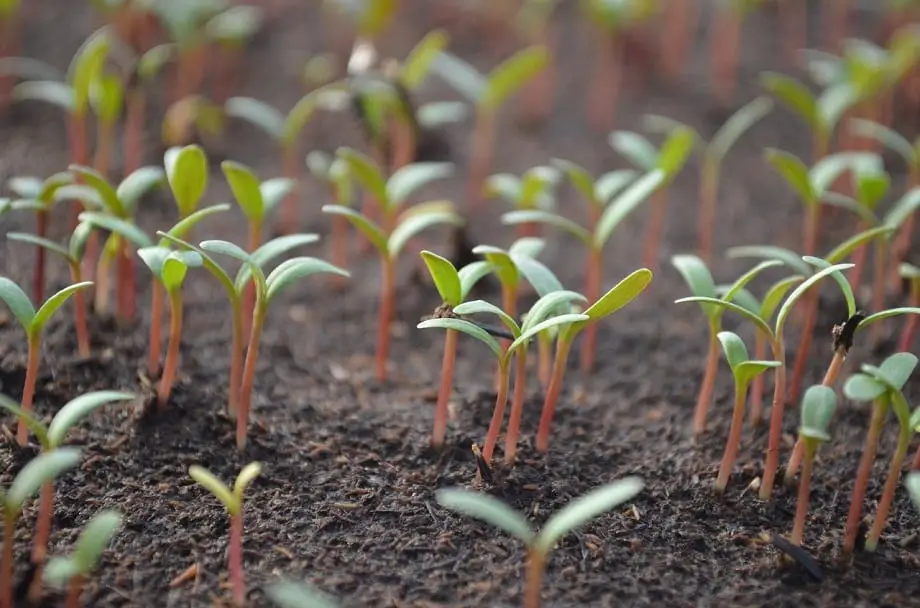
Correct spacing when planting tomatoes helps with optimal yield as it caters to the nutritional and lighting needs of the plant, ultimately allowing healthy growth and maximum fruit production.
Researchers at UC Davis Vegetable Research and Information Center emphasize the importance of air circulation for tomatoes since the lack of it can spread diseases very quickly.
Thus, correctly spacing tomatoes is essential as it helps plant growth in monumental ways. We’ll get more into this later.
First, let’s discuss all the different factors to keep in mind when planting tomatoes and how far apart they need to be.
When planting tomatoes, think about the variety of tomatoes you will be planting and how much space they will require to fully flourish in your garden.
Now, when it comes to gardens, you can plant in traditional rows and square gardens – even in raised garden beds. With certain tomato varieties, you can also opt for different container sizes to grow this incredibly versatile fruit.
Considering all these factors together allows you to make the best spacing choices for your tomatoes so that you can enjoy your very own homegrown fruit.
Let’s look at all these factors in detail below.
Spacing By Tomato Variety
Tomatoes can essentially be divided into two main varieties: determinate and indeterminate tomatoes. However, tomatoes are also found in dwarf and container varieties that can be planted quite close together.
Let us take a detailed look at different tomato varieties along with their spacing needs.
Determinate Varieties
Determinate tomatoes are compact and take up less space, as they stop growing after a certain height.
These tomatoes are usually hybrid varieties specifically bred to take up less space. Thus, they are much easier to plant in smaller gardens.
This type of tomato is suitable to grow in a cage as it does not need much support. This characteristic makes it the perfect container variety tomato. The growing season for determinate tomatoes is early in the year. After that, the plant declines.
When planting this tomato variety, a space of 1½ to 2 feet between each plant is considered adequate. You should allow 2 to 3 feet of space between rows.
Planting Determinate Tomatoes In Cages
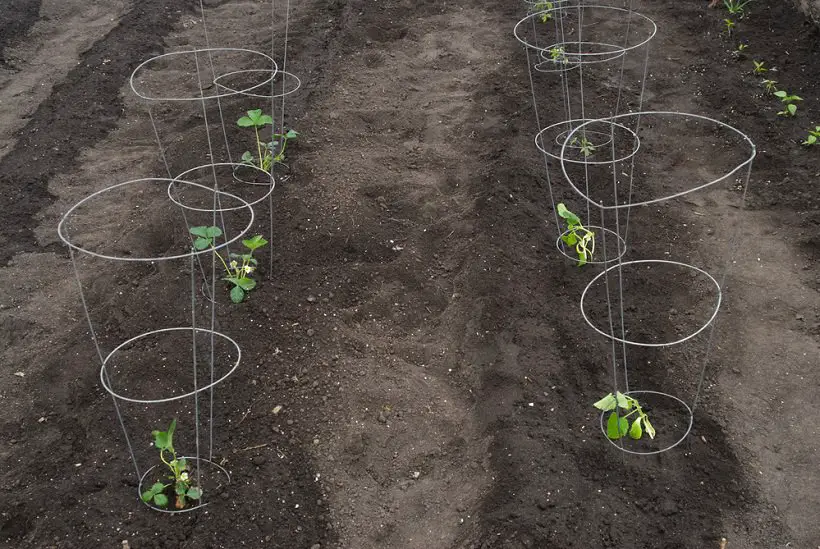
You can easily plant determinate tomatoes in cages as they usually grow up to a height of 2 to 4 feet – this could differ for different determinate tomato varieties. The predetermined height of the plant allows you to select the cage size best suited for your plant.
Allow yourself room to walk around the cage when planting these types of tomatoes.
In a cage, the recommended spacing for determinate tomatoes is approximately 2 feet (24 inches) between each plant with 4 feet (48 inches) left between each row.
It might seem like there is a lot of gap between the rows, but this will be spacious enough for you to easily access the plant for harvesting or pruning without risking any damage.
Similarly, container tomatoes are also usually determinate tomatoes simply because they do not require much support like staking within the pot.
However, even for determinate tomatoes that tend to grow as tall as 4 feet, it is crucial to use containers with a capacity of 5 gallons. Naturally, you can place the containers as close as you would like.
Indeterminate Varieties
Just as the name suggests, with indeterminate tomatoes you cannot gauge the final height of the plant. Thus, these types of tomatoes require much more spacing when compared to determinate varieties, and they benefit from stacking that provides added support. Almost all heirloom tomatoes are indeterminate.
Compared to the determinant type, indeterminate tomatoes take longer to fruit; but, they have a much longer extended growing season – until the first frost hits.
Since this type of tomato grows better vertically rather than horizontally, using a vertical trellis would be a smart spacing choice. This would allow you to plant these tomatoes 1½ to 2 feet apart since they will grow upwards rather than outwards.
We recommend the H Potter 8 Foot Tall Garden Trellis made out of wrought iron.
However, plant indeterminate tomatoes approximately 2½ to 3 feet apart when using wire cages.
This kind of tomato needs much more space horizontally; therefore, a good planting should be anywhere between 3 to 4 feet. Indeterminate tomatoes can grow to be 8 feet tall, so they need a lot of room to stretch out.
If you have a more spacious garden, you can allow the plants room to free-range and sprawl, soaking up nutrients from a wider patch of soil. However, for the optimal growth of such plants in smaller gardens, staking is the only viable option.
Dwarf Varieties

Keep in mind that the name of this variety refers to the plant size, not the fruit size.
Dwarf varieties produce average-sized tomatoes, but you can plant them in compact spaces.
These tomatoes grow to the height of 2 to 4½ feet, making them perfect for containers. Generally, you can space these tomatoes just 12 inches apart.
However, staking or caging young plants can provide added support once the plant bears large fruits.
Quick Spacing Guide for Determinate, Indeterminate, And Container Varieties
- Determinate: Plants should be spaced 1½ to 2 feet apart with 2 to 3 feet between rows.
- Indeterminate: With a vertical trellis, they should be planted 1½ to 2 feet apart. In wire cages, you need more space, so plant tomatoes 2½ to 3 feet apart. Horizontally, you need 3 to 4 feet of space between plants to allow optimal growth.
- Dwarf: You can plant this variety as close as 1 foot apart.
- Container: At least a 5-gallon capacity container is needed.
Spacing In Different Garden Types
Another factor that affects spacing requirements for tomatoes is the garden type.
Growing Tomatoes In The Ground
You can plant tomatoes the traditional way in the ground in rows or square foot gardens.
Traditional Row Gardens
When planting in traditional row gardens, tomatoes need more space. You will have to space rows close to 4 feet apart. This is adequate spacing for better accessibility and air circulation. Tomato variety also comes into play when planting tomatoes within the rows.
Square Foot Gardens
Square foot gardens use foot sections for space division rather than rows. Depending on the variety of tomatoes you need to grow, you can determine the number of foot sections required for healthy growth.
This type of garden is more suitable for indeterminate varieties since they grow upwards, and trellises can support them. Thus, they do not take as much space as the determinate variety, which tends to be bushier.
If you were to grow a determinate variety in a square foot garden, you would need to know the specific spacing requirements.
If the tomatoes need 3 feet between rows and 2 feet between each plant, you will need 6 square feet to grow the plant successfully. In this way, you can determine how many plants you can grow in your square foot garden.
However, keep accessibility in mind and allow yourself space to reach the plant without damaging it.
Growing Tomatoes In Raised Beds
Another way to save space when planting tomatoes is to opt for raised beds.
Planting tomatoes on the four corners of the raised beds allows them to spill over the edges without competing for space. A 4×4 foot raised bed with good quality soil allows a good foundation for your tomato plant to root and grow. With raised beds, you cannot plant too many tomatoes due to space restrictions.
We recommend planting tomatoes in each corner of a 4×4 foot raised bed. However, the general spacing rule is to allow 1½ to 2 feet of space between the plants.
Growing Tomatoes In Containers
Containers are the best option to go with if you are growing tomatoes while short on space. However, you would be better suited sticking to dwarf or other determinate varieties for this type of garden.
The reason containers work well is because each plant has its own space in an individual container and does not have to fight for nutrients.
Keep in mind the minimum container size requirement for tomatoes: a 5-gallon capacity with pots of at least 14 inches diameter.
How Different Soil Types Affect Tomato Spacing
Tomatoes prefer loamy soil that is high in nutrients. Excellent quality soil will allow you to space your tomatoes a little closer since they will not be competing so vehemently for nutrients.
Dry, poor-quality soil means that you may even have to plant tomatoes further apart than recommended so that they can get enough nutrients to grow properly.
Why Spacing Tomatoes Is Important
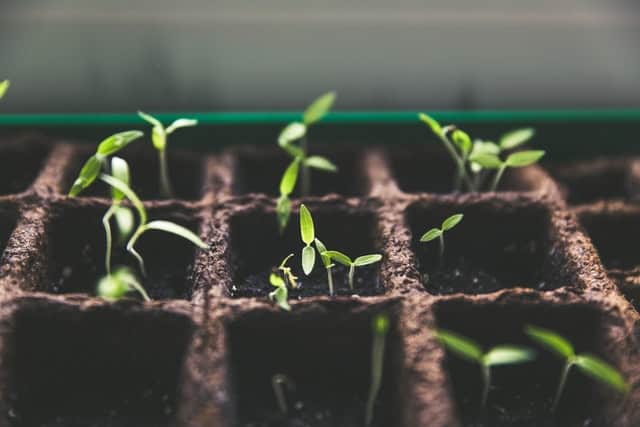
Now that we have discussed how far apart you should plant tomatoes for optimal growth based on differing factors, let us understand what would happen if you do not pay heed to proper spacing requirements.
Plant Health And Disease Prevention
The biggest reason for bug infestation and disease spread in tomato plants is that they are too close for adequate air circulation.
To avoid the spread of disease due to wet leaves, proper spacing between plants is a must. Spacing ensures that the leaves remain dry. Adequate spacing also lessens contact between plants, hindering bugs from moving from one tomato plant to another.
Nutritional Needs
Like all plants, tomatoes need water and nutrients from the soil to grow healthy and produce fruit.
Neglecting spacing requirements will result in plants fighting for soil nutrients that they need to flourish, flower, and produce fruit. Properly spaced out tomato plants do not compete with each other for nutrients and thus, grow much healthier.
Plants that do not receive enough water and nutrients from soil will more than likely be weak and eventually die.
Optimal Fruit Production
Spacing the plants too close to each other will result in weak stems – this ultimately affects fruit production.
Overcrowded plants do not produce as many flowers which means that there will be fewer tomatoes. Even when the fruit is produced, the stems won’t be able to support its weight.
With poorly spaced plants, there is also a risk of reduced pollination. So, even if your tomato plant has flowered, the lack of pollinators will eventually result in less fruit production.
Sun Requirements
Tomatoes require a good 6 to 8 hours of full sun to thrive. Naturally, closely spaced tomatoes will not allow sunlight to reach the plants as needed. This may result in fruit not ripening as desired.
Easy Accessibility
Last but not least, good spacing allows you to reach your tomato plant and fruit easily. Overcrowding the plants will pose a huge risk of damaging or trampling the tomatoes while watering, harvesting or pruning.
Thus, the correct spacing guarantees you can get to the plant when needed.
Conclusion
In conclusion, tomato plants thrive when spaced correctly according to their variety, garden type and soil quality. Overcrowded tomato plants tend to grow weaker and produce less fruit. They are also more prone to different diseases and pest infestations.
If you’re growing a plant from seed, you can check the label for type and spacing requirements. However, if you are unsure about the tomato variety and the kind of soil in your garden, remember that planting tomatoes farther apart is better.
When in doubt, plant tomatoes 4 feet apart per row, as well as allowing 4 feet of spacing between the rows. This will give your tomatoes the best chance to thrive and produce more fruit.
